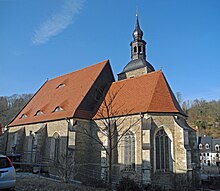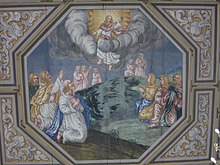St. Wolfgang (glassworks)

The Protestant town church of St. Wolfgang is a late Gothic church in the town of Glashütte in the Saxon Switzerland-Eastern Ore Mountains district in Saxony . It belongs to the parish of St. Wolfgang in the parish Glashütte of the Evangelical Lutheran Church of Saxony and is known for its well-preserved organ from the time of classicism by Johann Christian Kayser , which is still very much in the tradition of Gottfried Silbermann .
History and architecture
In 1495 there was already a mountain chapel, which was elevated to a parish church in 1519. The new construction was carried out in the years 1520–1535, the upper floors of the tower date from 1580. Since 1668, several renovations have been carried out in every century, the measures in the years 1742–1747 and 1890/1891 were particularly extensive. The building is planned as a three-aisled, vaulted hall church, which is indicated by buttresses on the west wall and wall pillars on the east nave wall, but it was designed as a single nave with a high gable roof and a strongly recessed choir with three-eighths closure .
The church is built as a quarry stone building with sandstone structures, buttresses are attached to the nave and choir. Pointed arched portals with interlaced frameworks on the north and west sides open up the structure. Wide, three-lane tracery windows with just about pointed arches illuminate the interior. In the north-east corner is the four-storey tower with a Welscher dome and rectangular windows, which are provided with frame reveals on the two basement floors . The sacristy is on the first floor of the tower.
The ship, which has an approximately square floor plan (18 × 14.5 m), ends with a well-designed wooden coffered ceiling , which is marked 1668. The paintings were done by Johann Hauffen. Resurrection and Ascension are depicted in two octagonal medallions, which are framed by smaller fields like a chessboard, which are alternately adorned with ornaments and a total of 74 music-making angels. Galleries are built in on three sides and painted around 1890. The second north gallery, built in 1724, was demolished in 1890/1891 together with the old council gallery and the latter was replaced by a smaller, new one. The panels of the old council gallery were painted by Hans Panitz with 14 scenes from the New Testament (dated 1626). They were set up in the choir with a new wooden frame. A pointed triumphal arch leads to the choir, which is finished with a simply painted wooden coffered ceiling, dated 1616. On the north wall of the choir there are two late Gothic portals with interlaced frameworks.
Furnishing
The main part of the furnishings is a two-story, painted, wooden altar with reliefs that are dated to 1613. In the main field there is a depiction of the Lord's Supper , including Christ on the Mount of Olives , above the crucifixion and a triumphant Christ. Three-dimensional evangelist figures are set up to the side of the columns .
The carved wooden miner's pulpit , dated 1650, shows an upper climber dressed in festive costume as the pulpit bearer, who stands on a real stone step . According to the inscription, the pulpit pictures were painted by Balthasar and Hans Gottfried Böhme from Dresden. Christ, four angels holding coats of arms, John and Peter are depicted on the pulpit, and evangelists on the staircase. The baptismal font made of sandstone from the turn of the 16th century.
In the church, valuable remains of a winged altar are kept on the choir walls, which were found on the church floor in 1836 and then restored. This includes four rectangular panels depicting the Annunciation and Saint Lawrence and Martin from around 1520.
Figurative tombstones made of painted sandstone by Pastors Kittel († 1639) and Hartung († 1679) stand on the north wall of the choir. On the southern wall of the nave there is a portrait of Elector Johann Georg I and his wife Magdalena Sibylla from the 17th century. The church received the figures of Peter and Paul standing on the stumps of the pillars as a gift in 1891.
organ
In 1597 an unknown organ builder built a small organ , which Gottfried Fritzsche implemented and expanded in 1608 . In 1730 the community acquired the used organ from the Reinhardtsgrimma village church , for which Gottfried Silbermann created a new work.
Today's organ in St. Wolfgang has 18 stops on two manuals and a pedal and is a work by Johann Christian Kayser from 1797. In 1855 the instrument was repaired by Karl Traugott Stöckel , in 1857 the bellows were examined by Karl August Schröder. After minor repairs had been carried out by a local carpenter in 1861, the Jehmlich brothers carried out a major repair in 1862, presumably installing the Aeoline 8 ′ and Schwiegel 8 ′ registers. In 1872 Karl Traugott Stöckel renewed parts of the action and built in box bellows. In 1917 the prospect pipes were handed in (later replaced by pipes made of zinc) and an electric centrifugal fan was installed. In 1960 Jehmlich carried out cleaning and impregnation, overhauling the pipework and replacing wooden parts infested with anobia . Sifflet 1 'was used instead of Aeoline 8' and the additional Schwiegel 8 'register was removed from the upper work. The disposition is:
|
|
|
|||||||||||||||||||||||||||||||||||||||||||||||||||||||||||||||
- Coupling : II / I, I / P
- Playing aids : Calcantenruf
Peal
The ringing consists of four bronze bells , the bell cage is made of oak, as are the bell yokes and were renewed in 2009. Below is a data overview of the bell:
| No. | Casting date | Caster | material | diameter | Dimensions | Chime |
|---|---|---|---|---|---|---|
| 1 | 2009 | Bell foundry P. Grassmayr | bronze | 1072 mm | 764 kg | G' |
| 2 | 2009 | Bell foundry P. Grassmayr | bronze | 906 mm | 453 kg | b ′ |
| 3 | 2009 | Bell foundry P. Grassmayr | bronze | 808 mm | 324 kg | c ″ |
| 5 | 1526 | Bell foundry M. Hilliger | bronze | 467 mm | 65 kg | H" |
literature
- Georg Dehio: Handbook of the German art monuments. Saxony I. District of Dresden. Deutscher Kunstverlag, Munich 1996, ISBN 3-422-03043-3 , pp. 362–363.
- Rainer Thümmel : Bells in Saxony . Sound between heaven and earth. Ed .: Evangelical Regional Church Office of Saxony . 2nd, updated and supplemented edition. Evangelische Verlagsanstalt, Leipzig 2015, ISBN 978-3-374-02871-9 , p. 299 (With a foreword by Jochen Bohl and photographs by Klaus-Peter Meißner}).
Web links
Individual evidence
- ↑ a b Information about the organ on orgbase.nl. Retrieved April 27, 2019 .
- ^ Ulrich Dähnert: Historical organs in Saxony . 1st edition. Verlag Das Musikinstrument, Frankfurt am Main 1980, ISBN 3-920112-76-8 , p. 124-125 .
- ^ A b Rainer Thümmel : Bells in Saxony . Sound between heaven and earth. Ed .: Evangelical Regional Church Office of Saxony . 2nd, updated and supplemented edition. Evangelische Verlagsanstalt, Leipzig 2015, ISBN 978-3-374-02871-9 , pp. 299 (With a foreword by Jochen Bohl and photographs by Klaus-Peter Meißner).
Coordinates: 50 ° 51 ′ 8.1 ″ N , 13 ° 46 ′ 36.4 ″ E





